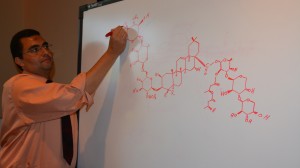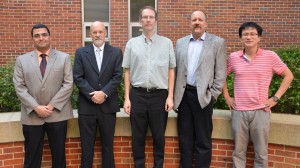OXFORD, Miss. – Many plant species facing extinction may contain metabolites that can fight human disease, according to a recent paper published in the Proceedings of the National Academy of Sciences.
The article – which reports work conducted by scientists in the University of Mississippi School of Pharmacy and other collaborators – describes the human health implications associated with the protection and assessment of threatened and endangered plants.
“This study reveals that endangered plants and their endophytes can provide potential treatments for serious human diseases,” said Mohamed Ali Ibrahim, the paper’s first author and a postdoctoral research associate at UM’s National Center for Natural Products Research.
Specifically, the paper highlights a study of Diplostephium rhododendroides Hieron., a plant found only in the mountains of Ecuador and Colombia. The National Cancer Institute’s Natural Products Branch collected and screened the plant material to determine possible drug leads for treating hepatitis C virus, or HCV, and diabetes.
“This plant is rare, and we were provided with a very limited amount of it,” Ibrahim said. “Because of the geographical location of this plant, collecting more was not feasible. This, in turn, required the use of state-of-the-art scientific instrumentation to isolate the plant’s biologically active compounds and determine their chemical structures.”
Ibrahim and MinKyun Na, a former postdoctoral fellow at UM, isolated two sets of metabolites and confirmed their activity. Then Ibrahim was tasked with determining the complete structures of three complex glycosides.
“The metabolites are unusually complex and would likely have never been discovered without an increased focus on studying and protecting rare plants,” he said. “I would spend my entire day on the computer looking for the smallest details in the structure. It took a considerable amount of time, but the efforts paid off.”
UM pharmacognosy professor Mark T. Hamann directed the work of Ibrahim and a team of other students and collaborators to complete the study.
“Two unique sets of drug leads were identified by Drs. Ibrahim and Na, one for HCV and another for diabetes,” said Hamann, the paper’s corresponding author. “Although neither set of molecules will likely be developed into actual treatments, this paper exemplifies the importance of preserving rare species and species diversity, with the goal of accessing these resources for treatments for emerging diseases in the future. I was thrilled to see the study, which reflects the extraordinary talent and dedication of our pharmacognosy graduate students, published in PNAS.”
Joonseok Oh, a UM student pursuing a doctoral degree in pharmacognosy, created high-quality images of the structures and conducted molecular docking studies with Robert J. Doerksen, an associate professor of medicinal chemistry and one of the paper’s coauthors.
“The extinction of such fragile plants would lead to the permanent loss of promising opportunities to develop unique and promising treatments,” Oh said.
Raymond F. Schinazi, Frances Winship Walters Professor of Pediatrics and director of the Laboratory of Biochemical Pharmacology at Emory University School of Medicine and a senior research career scientist at the Atlanta Veterans Affairs Medical Center, helped design the research.
Louis Zachos , a UM assistant professor of geological engineering, created a map showing the global distribution of endangered plants to accompany the article.
“It was an interesting challenge to determine how to display in a continuous form data that was collected at a grainy resolution, while maintaining the integrity and meaning of the underlying information,” Zachos said. “Representation of the island biogeography was particularly challenging.”
Daneel Ferreira, chair of UM’s pharmacognosy department, applauds the research reported in the article.
“There are two issues at stake here,” Ferreira said. “Since the mortality rates from HCV infections were recently shown to exceed those from HIV-1 infections, there is an urgent need for the discovery and development of new anti-HCV drugs. Also, the fact that Dr. Ibrahim’s research led to the discovery of potential HCV and diabetes drugs from an endangered plant emphasizes the importance of an increased focus into the research of endangered plants and efforts to protect these valuable renewable natural resources.”
Ferreira said that Ibrahim displayed an experience level “well beyond that of an average graduate student” and that he has an “insatiable aptitude” towards understanding, rather than memorizing, fundamental principles of chemistry and biology. Ibrahim was awarded a four-year scholarship from the Egyptian government to pursue his doctoral degree at Ole Miss.
“This is a very interesting and informative paper that is representative of the superior research that Dr. Ibrahim and his collaborators conduct,” said Larry Walker, director of the National Center for Natural Products Research. “We are so pleased that Dr. Ibrahim has continued to work at the NCNPR after completing his training with Dr. Hamann.”
Doerksen thinks the PNAS article will raise awareness of the importance of conserving drug-producing plant species.
“Most readers will realize that we need to place greater emphasis on the preservation and study of endangered plants in order to aid the discovery and development of new generations of drugs,” he said.
Ibrahim credits UM faculty, as well as his family for their encouragement.
“I am so thankful to my mentor Dr. Hamann and the pharmacognosy professors for their constructive discussions and lectures,” he said. “I’m also grateful to my family members for their support. I’m dedicating this work to my father, who passed away in November of 2011.”
Read the full paper here.

